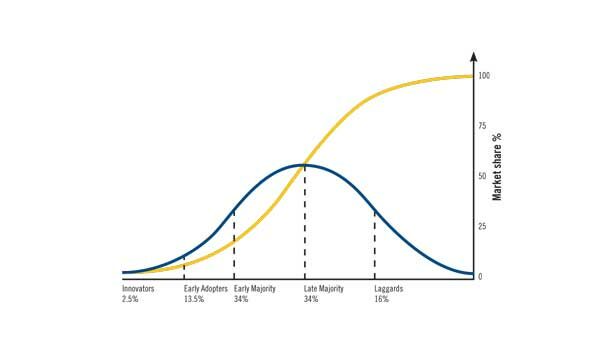Ready or Not, Here IP Comes
Why should you care when IP surveillance will dominate the market? Research on how innovations are diffused suggests that the shift to IP might be faster than current forecasts indicate.


Early adopters of IP-based surveillance include the education and healthcare markets, due in large part to a network infrastructure already in place or being built. Those who made the switch, such as Chippewa Valley Schools, often cite the superior image quality, functionality, scalability and total cost of ownership benefits of network video


It is becoming increasingly obvious that the video surveillance industry is undergoing a technological shift. Analog cameras are being replaced by digital, IP-based cameras. Although IP has grown significantly since the early 2000s, it started from very low levels and it is not until more recently that the shift has gained momentum.
Because this transition will impact the entire industry, it is important to understand how fast the diffusion of IP surveillance will be in the coming years. If security dealers and systems integrators are not geared up for the complete propagation of IP video technology — with knowledge of its impact on their companies, research on market needs, a fully trained staff, and understanding of product choices — they surely will be left behind in the old world of security.
Current estimates by IMS Research suggest that 50 percent of the market will have shifted to IP by 2014, as compared with today’s level around 25 percent. I argue that current forecasts of IP growth suffer from a too linear view on adoption and that the transition to IP will happen faster than many expect.
Let’s start by looking at some more general academic work on how innovations are adopted in society. Everett M. Rogers’ seminal book Diffusion of Innovations (published 1962) provides a good starting point. He categorized adopters according to their willingness to use an innovation. The first to adopt are referred to as innovators and constitute 2.5 percent of the total population. The next group is called early adopters (13.5 percent), which is in turn followed by the early majority (34 percent), the late majority (34 percent) and the laggards (16 percent).
Rogers noted in his research on the topic that diffusion happens in an epidemic way. Once a critical mass of the population has adopted an innovation, the shift gains momentum and the pace of diffusion increases significantly. When the early and late majorities have changed, diffusion levels off and the market reaches a mature stage. Therefore, the adoption of an innovation follows an S-shaped pattern where diffusion is initially slower than expected, then happens very rapidly and eventually the market becomes saturated. The S-curve pattern has rarely been contested among scholars and it is more or less taken for granted that diffusion happens in this way.
The shift to digital photography can serve as an illustrative example of the S-curve. In 2000, the following statement was made by the CEO of Kodak, Dan Carp:
“It will take more than one company to change a century of consumer habits and perception. With the participation of the entire industry, I am confident that we can lead the way toward a more picture-rich era, and that, together, we can break through the technical and marketing challenges facing our industry.”
In retrospect, the quote seems quite perplexing, bearing in mind that virtually everyone had a digital camera a few years later. But in 2000, only innovators and early adopters had started to use digital cameras and the product was still regarded as a toy or a gadget. In the following years, the early and late majorities could be reached since prices had declined and the performance of digital cameras had increased. Rogers’ words from 1962 summarize the pattern eloquently:
“The heart of the innovation diffusion can be found somewhere between 10 and 20 percent… After that point, it is often impossible to stop the further diffusion of a new idea, even if one wished to do so.”
In fact, Kodak used the S-curve logic back in 1994 in order to predict when 50 percent of the market will be digital. They concluded that this would happen in 2004, a forecast that was rather accurate since 50 percent of the market was digital in 2003.
Enough theory; let’s turn back to video surveillance. It seems as though the first adoption of IP surveillance by innovators and the early majority happened between 1999 and 2003. People with IT skills could see the benefits of the technology and were happy to use it. In the following years, growth started to take off as early adopters could see the advantages of scalability and online access. But in absolute numbers, IP was still rather insignificant in comparison with analog CCTV. As IP’s share of the market totaled to about 15 percent in 2007, the technology had, at this point, been diffused to the innovators and the early adopters.
The recession probably caused a slowdown in the following years but nevertheless, about 25 percent of the market had shifted to IP surveillance by 2010.
The diffusion process has now entered its steeper phase where the early and late majorities can be expected to shift over to IP. As stated previously, current forecasts predict that 50 percent of the market will choose IP in 2014. Given the underlying dynamics of the S-curve, this might happen faster than expected. The early majority has started to use IP and this usually implies that the diffusion has reached the lowest point of the steeper phase of the S-curve, which in turn speaks for a surprisingly rapid diffusion in the coming years. While it’s always difficult to make forecasts, this reasoning would suggest that IP may have captured 50 percent of the market already in 2012 - 2013.
I see a couple of arguments in favor of a faster diffusion. First and perhaps most important, the performance of IP cameras has increased significantly in recent years. With the emergence of megapixel and HD cameras, the image quality is not a problem any longer. On the contrary, IP has probably outperformed CCTV along this performance dimension. Moreover, IP cameras are easier to install nowadays, they contain more features and offer an increased scalability.
Second, while growth in absolute numbers decreased during the recession, the underlying forces in favor of IP kept pushing the technology forward. IP firms continued to spend money on marketing and on education activities. More people than ever before now have a sufficient command of the technology, and current growth figures suggest that IP is now gaining momentum as the recession is over.
One critical barrier for further diffusion of IP can be found in smaller installations. These customers do not benefit from scalability to the same extent and they are also more price-sensitive. Analog CCTV is still relatively strong in this sector. Thus, diffusion of IP can be increased if products and business models that suit this segment are developed.
Gabriel Tarde, perhaps the first scholar who worked on diffusion, wrote the book, The Laws of Imitation in 1890, in which he made the following statement:
“A slow advance in the beginning, followed by a rapid and uniformly accelerated progress, followed again by progress that continues to slacken until it finally stops: these are the three ages of invention. If taken as a guide by the statistician and the sociologist, they would save many illusions.”
Based on all our previous knowledge concerning diffusion along with the current state of the security industry, I would regard Tarde’s words as a very good piece of advice to everyone in the security business.
Looking for a reprint of this article?
From high-res PDFs to custom plaques, order your copy today!










